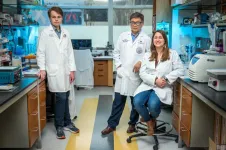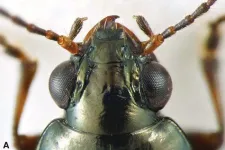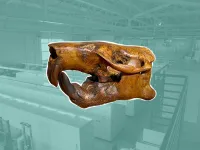(Press-News.org) AUGUSTA, Ga. (March 28, 2023) – Cancer that has spread to areas like the lungs can apply the brakes to a natural pathway that should recruit killer T cells directly to where it has metastasized, scientists report.
That newly found strategy used by tumors that have spread — and are consequently more deadly — may help explain why sometimes promising immunotherapies designed to help the immune system kill cancer don’t, says Kebin Liu, PhD, cancer immunologist in the Department of Biochemistry and Molecular Biology at the Medical College of Georgia.
It also may mean an additional therapeutic maneuver is needed to stop some tumors, which often are diagnosed after they have spread, says Liu, corresponding author of the study in the journal Cancer Cell.
T cells are drivers of the immune response which cancer tries to waylay, and drugs like Keytruda (pembrolizumab) and OPDIVO (nivolumab), also known as immune checkpoint inhibitors, try to set these “killer” T cells free.
The mutual target of cancer and these drugs is PD-1, a protein and natural checkpoint that enables T cells to be turned on or off.
The protein PD-L1 naturally binds to PD-1 to effectively turn the T cells off, which is a good thing, when helping avoid, for example, an overzealous immune response to your own body tissue which results in conditions like lupus.
But cancer usurps this natural switch to protect itself in a move dubbed “immunoescape.”
“PD-L1 is the brake,” say Liu. “The PD-L1 cancer cells express is in direct response to the PD-1 that T cells express. One of the reasons people may not have the success you would expect with immunotherapy is the smartness of the tumor in using PD-L1.”
Cancer binds to the PD-1 on T cells, effectively turning them off. Drugs like Keytruda bind to and block the receptor for PD-1 on T cells to keep them free to attack.
But Liu and his colleagues have found that there is more to the story, particularly when it comes to the spread of cancer, which is responsible for more than 90% of cancer mortality.
Immune cells called myeloid cells talk to T cells and can also both activate and prevent these frontline responders from attacking an invader like cancer or a virus. Myeloid cells also express PD-1.
Liu and his colleagues found that metastatic tumor cells also directly engage with the PD-1 on these myeloid cells, where they suppress a natural pathway that produces type 1 interferon, which they found is essential to bringing “killer” T cells right to the spreading cancer’s doorstep.
Interferon is a natural protein made by our cells that is known to help the body fight invaders like a virus or cancer. It’s also synthetically produced to treat a variety of conditions from skin cancer to hepatitis.
“The tumor uses PD-L1 to bind to the PD-1 on the myeloid cells therefore the myeloid cells cannot produce interferon to help the T cells infiltrate the tumor,” Liu says of their findings in cancer metastasis.
They found that the signaling pathway for this interferon is essential to the recruitment of killer T cells to, in this case, the site of cancer that has spread to the lungs. They found in this scenario the PD-L1 from cancer cells interacts directly with the PD-1 on myeloid cells to suppress interferon’s production.
They already are working to see if this happens at other common sites for cancer spread like the liver. The lung and liver are usual sites of metastasis for a variety of cancers, Liu notes. Breast cancer, for example, is known to spread to the bone, brain, liver and lung, according to the National Cancer Institute. The liver and lung are also major sites of metastasis for cancer of the kidney, melanoma, as well as ovarian, prostate and pancreatic cancer. Primary lung cancer can spread to a number of sites including the adrenal gland and liver but also to the other lobe of the lung.
Liu is also pursuing a more direct approach for targeting cancer’s metastatic disease maneuver, working with biomedical engineers at Boston University on a molecule that will force the tumor cells themselves to express interferon so they cannot escape being invaded by T cells. “We want to put a bomb inside the tumor’s house,” he says.
Type 1 interferon alpha was the first immunotherapy approved by the Food and Drug Administration and there is emerging evidence that type 1 interferon enables conversations between immune cells that are in the tumor’s supportive microenvironment, they write. They and others have shown that type 1 interferon induces both PD-1 and PD-L1 in myeloid cells. And type 1 interferon has been shown to be silenced in areas of cancer spread.
The research was funded by the National Institutes of Health and a Veterans Administration Merit Review Award. Liu is a faculty member in the Georgia Cancer Center and an affiliated faculty member in MCG’s new Immunology Center of Georgia.
Read the full study.
END
Cancer that spreads to the lung maneuvers to avoid being attacked by “killer” T cells
2023-03-28
ELSE PRESS RELEASES FROM THIS DATE:
Hispanic, Black, and low-income adults are less likely to replace smoking with vaping
2023-03-27
FOR IMMEDIATE RELEASE
March 27, 2023
Contact:
Jillian McKoy, jpmckoy@bu.edu
Michael Saunders, msaunder@bu.edu
##
Growing evidence suggests that e-cigarettes may serve as a less harmful alternative to smoking traditional cigarettes, but socioeconomic and racial inequities in cigarette and e-cigarette use are preventing certain populations from reaping these potential health benefits, according to a new study led by Boston University School of Public Health (BUSPH) and the Keck School of Medicine of the University of Southern California (Keck School of Medicine of USC).
Published in the American Journal of Preventive ...
Rare beetle, rediscovered after 55 years, named in honor of Jerry Brown
2023-03-27
Berkeley — When University of California, Berkeley, entomologist Kipling Will first heard that former Gov. Jerry Brown was hosting field scientists on his Colusa County ranch, he jumped at the chance to hunt for beetles on the property.
“I reached out and said, ‘Hey, I want to sample your beetles,’” Will said. “And [Brown] was quite game to let me come up there.”
Will, a professor of environmental science, policy and management, has travelled to all corners of California ...
JNM explores potential applications for ChatGPT in nuclear medicine and molecular imaging
2023-03-27
Reston, VA—A new article in The Journal of Nuclear Medicine explores the potential for using ChatGPT, an artificial intelligence chatbot, in the field of nuclear medicine and molecular imaging. In the article, Irène Buvat, PhD, and Wolfgang Weber, MD, PhD, report on discussions they held with ChatGPT regarding several nuclear medicine and molecular imaging topics and provide their commentary on the pros and cons of using the chatbot.
Developed by OpenAI, ChatGPT is a natural language processing chatbot that can intelligently respond to questions. ...
Aging | Parsing chronological and biological age effects on vaccine responses
2023-03-27
“Ultimately, while both chronological and biological age appear to be important determinants of vaccine-preventable outcomes in older adults, the underlying context and mechanisms of their effects remain unclear.”
BUFFALO, NY- March 27, 2023 – A new editorial paper was published in Aging (listed by MEDLINE/PubMed as "Aging (Albany NY)" and "Aging-US" by Web of Science) Volume 15, Issue 5, entitled, “Parsing chronological and biological age effects on vaccine responses.”
Researchers ...
Beneficial bacteria in the infant gut uses nitrogen from breast milk to support baby’s health
2023-03-27
A University of Massachusetts Amherst nutrition scientist who has spent his career studying breast milk has demonstrated how beneficial microbes in the gut of infants use nitrogen from human milk to support pediatric nutrition and development.
“The molecules in breast milk not only feed the baby but also feed the baby’s microbiome,” says David Sela, associate professor of food science and director of the Fergus M. Clydesdale Center for Foods for Health and Wellness. “This ...
Study finds neighborhood apps increase perceptions of crime rates
2023-03-27
How often do you glance at your neighborhood app, like Nextdoor or others, and learn about some crime in your area? Surely, it was not the intention of the app developers, but every time you hear of a crime nearby you might think that crime in your area is rampant. A new study by a University of Houston psychologist indicates that is exactly how the mind works – those helpful and popular neighborhood apps are actually increasing perceptions of crime rates that may not be as high as you think.
“Neighborhood ...
Can cannabis use disorder be accurately diagnosed?
2023-03-27
Cannabis use disorder is defined by the Diagnostic and Statistical Manual of Mental Disorders as a problematic pattern leading to clinically significant impairment or distress, with symptoms that may include increased tolerance, withdrawal symptoms, strong desire to use marijuana and spending large amounts of time using cannabis.
Tammy Chung, director of the Center for Population Behavioral Health at Rutgers Institute for Health, Health Care Policy and Aging Research, along with colleagues Marc Steinberg of Rutgers Robert Wood Johnson Medical School and Mary Barna Bridgeman of the Rutgers ...
SCAI and HRS release expert consensus on transcatheter left atrial appendage closure
2023-03-27
WASHINGTON (March 27, 2023) – Today, the Society for Cardiovascular Angiography & Interventions (SCAI) and the Heart Rhythm Society (HRS) released an updated expert consensus statement on transcatheter left atrial appendage closure (LAAC). SCAI and HRS prioritized the development of an updated consensus statement to provide recommendations on contemporary, evidence-based best practices for transcatheter LAAC focusing on endovascular devices.
Left atrial appendage closure is a minimally invasive procedure that is used to reduce the risk of stroke associated with atrial fibrillation. ...
Beaver fossil named after Buc-ee’s
2023-03-27
A new species of ancient beaver that was rediscovered by researchers in The University of Texas at Austin’s fossil collections has been named after Buc-ee’s, a Texas-based chain of popular travel centers known for its cartoon beaver mascot.
The beaver is called Anchitheriomys buceei, or “A. buceei” for short.
Steve May, a research associate at the UT Jackson School of Geosciences, said that the beaver’s Texas connection and a chance encounter with a Buc-ee’s billboard are what inspired the name.
May is the lead author of the paper that describes A. buceei, along with another, much smaller, species of fossil beaver. Published ...
James Chappell wins NSF CAREER Award
2023-03-27
HOUSTON – (March 27, 2023) – Rice University bioscientist and synthetic biologist James Chappell has won a National Science Foundation CAREER Award to develop RNA programming methods to improve human health and the environment.
“Synthetic biology has progressed a lot in the past decade, and we’ve gotten really good at genetically programming microbes in confined laboratory environments where conditions are ideal,” said Chappell, an assistant professor both of biosciences and of bioengineering. “But, of course, most microbes on the planet don't live in pure cultures where the temperature is always 37 degrees ...









